Corrosion Behavior and Strength of Dissimilar Bonding Material between Ti and Mg Alloys Fabricated by Spark Plasma Sintering
Abstract
:1. Introduction
2. Materials and Methods
3. Results and Discussion
3.1. Microstructure Analysis
3.2. Bonding Strength Evaluation
3.3. Surface Potential Measurement at Bonding Interface of Dissimilar Materials
3.4. Corrosion Behavior Analysis of Dissimilar Materials
4. Conclusions
- Ti and Mg alloys (ST) were successfully bonded with an advanced new method, spark plasma sintering without applying any inserted sheet. The surfaces of Ti and Mg alloy (ST) were perfectly contacted without any cracks or voids because of the high bonding pressure.
- The formation of Al diffusion and Ti3Al layer at the nano-level were proven by controlling the bonding strength of bonding materials. A uniform and thick Ti3Al layer (about 50 nm) was required in order to obtain the maximum bonding strength and bonding efficiency of dissimilar materials.
- The galvanic corrosion of dissimilar materials could be improved by formation of Ti3Al IMC layer. This IMC layer has a surface potential between Ti and Mg alloy, which prevents large and abrupt changes in surface potential at the bonding interface, and improves galvanic corrosion resistance
- The mass loss of dissimilar materials was controlled by Al content in Mg alloy. The high Al content in Mg alloy contributed to a formation of a stable Mg–Al–O film, which lowers the surface potential, and resulted in high corrosion resistance on Mg alloy matrix. The galvanic corrosion may contribute to mass loss because of severe galvanic corrosion, such as in Ti/AZ31B (ST).
Author Contributions
Conflicts of Interest
References
- Hu, Z.H.; Zhan, Y.Z.; She, J. The role of Nd on the microstructural evolution and compressive behavior of Ti-Si alloys. Mater. Sci. Eng. A 2013, 560, 583–588. [Google Scholar] [CrossRef]
- Hao, Y.; Liu, J.; Li, J.; Li, S.; Wang, G. Investigation on dynamic properties and failure mechanisms of Ti-47Al-2Cr-2Nb alloy under uniaxial dynamic compression at a temperature range of 288 K-773 K. J. Alloys Compd. 2015, 649, 122–127. [Google Scholar] [CrossRef]
- Huda, Z.; Edi, P. Materials selection in design of structures and engines of supersonic aircrafts: A review. Mater. Des. 2013, 46, 552–560. [Google Scholar] [CrossRef]
- Ghosh, A.; Sivaprasad, S.; Bhattachajee, A.; Kar, S.K. Microstructure-fracture toughness correlation in an aircraft structural component alloy Ti-5Al-5V-5Mo-3Cr. Mater. Sci. Eng. A 2013, 568, 61–67. [Google Scholar] [CrossRef]
- Murray, J.L. Bulletin of Alloy Phase Diagrams; Springer: New York, NY, USA, 1986. [Google Scholar]
- Atieh, A.M.; Khan, T.I. TLP bonding of Ti-6Al-4V and Mg-AZ31 alloys using pure Ni electro-deposited coats. J. Mater. Process. Tech. 2014, 214, 3158–3168. [Google Scholar] [CrossRef]
- Fouad, Y. Characterization of a high strength Al-alloy interlayer for mechanical bonding of Ti to AZ31 and associated tri-layered clad. Alex. Eng. J. 2014, 53, 289–293. [Google Scholar] [CrossRef]
- Shifler, D. Understanding material interactions in marine environments to promote extended structural life. Corros. Sci. 2005, 47, 2335–2352. [Google Scholar] [CrossRef]
- Emley, E.F. Principles of Magnesium Technology; Pergamon Press: London, UK, 1966; p. 685. [Google Scholar]
- Baboian, R.; France, W.D.; Rowe, L.C.; Rynewicz, J.F. Galvanic and Pitting Corrosion--Field and Laboratory Studies, STP 576; American Society for Testing and Materials: Philadelphia, PA, USA, 1974. [Google Scholar]
- Funutsu, K.; Fukuda, H.; Takai, R.; Umeda, J.; Kondoh, K. Quantitative evaluation of initial galvanic corrosion behavior of CNTs reinforced Mg-Al alloy. Adv. Powder. Technol. 2013, 24, 833–837. [Google Scholar] [CrossRef]
- Huang, C.A.; Wang, T.H.; Han, W.C.; Lee, C.H. A study of the galvanic corrosion behavior of Inconel 718 after electron beam welding. Mater. Chem. Phys. 2007, 104, 293–300. [Google Scholar] [CrossRef]
- Afshar, F.N.; Glenn, A.M.; de Wit, J.H.W.; Terryn, H.; Mol, J.M.C. A combined electron probe micro analysis and scanning Kelvin probe force microscopy study of a modified AA4xxx/AA3xxx aluminium brazing sheet. Electrochim. Acta 2013, 104, 48–63. [Google Scholar] [CrossRef]
- Fei, P.; Qu, Z.; Wu, R. Microstructure and hardness of Mg-9Li-6Al-xLa (x = 0, 2, 5) alloys during solid solution treatment. Mater. Sci. Eng. A 2015, 625, 169–176. [Google Scholar] [CrossRef]
- Lou, Y.; Li, L.; Zhou, J.; Na, L. Deformation behavior of Mg-8Al magnesium alloy compressed at medium and high temperatures. Mater. Charact. 2011, 62, 346–353. [Google Scholar] [CrossRef]
- Jiang, Q.; Ma, X.; Zhang, K.; Li, Y.; Li, X.; Li, Y.; Ma, M.; Hou, B. Anisotropy of the crystallographic orientation and corrosion performance of high-strength AZ80 Mg alloy. J. Magnes. Alloys 2015, 3, 309–314. [Google Scholar] [CrossRef]
- Wilke, B.M.; Zhang, L.; Ning, W.L.C.; Chen, C.; Gu, Y. Corrosion performance of MAO coatings on AZ31 Mg alloy in simulated body fluid vs. Earle’s Balance Salt Solution. Appl. Surf. Sci. 2016, 363, 328–337. [Google Scholar] [CrossRef]
- Cole, G.S. Corrosion Prevention of Mg Alloys; Woodhead publishing: Cambridge, UK, 2013; pp. 489–508. [Google Scholar]
- Chan, C.W.; Man, H.C.; Yue, C.M. Effect of post-weld heat-treatment on the oxide film and corrosion behavior of laser-welded shape memory NiTi wires. Corros. Sci. 2012, 56, 158–167. [Google Scholar] [CrossRef]
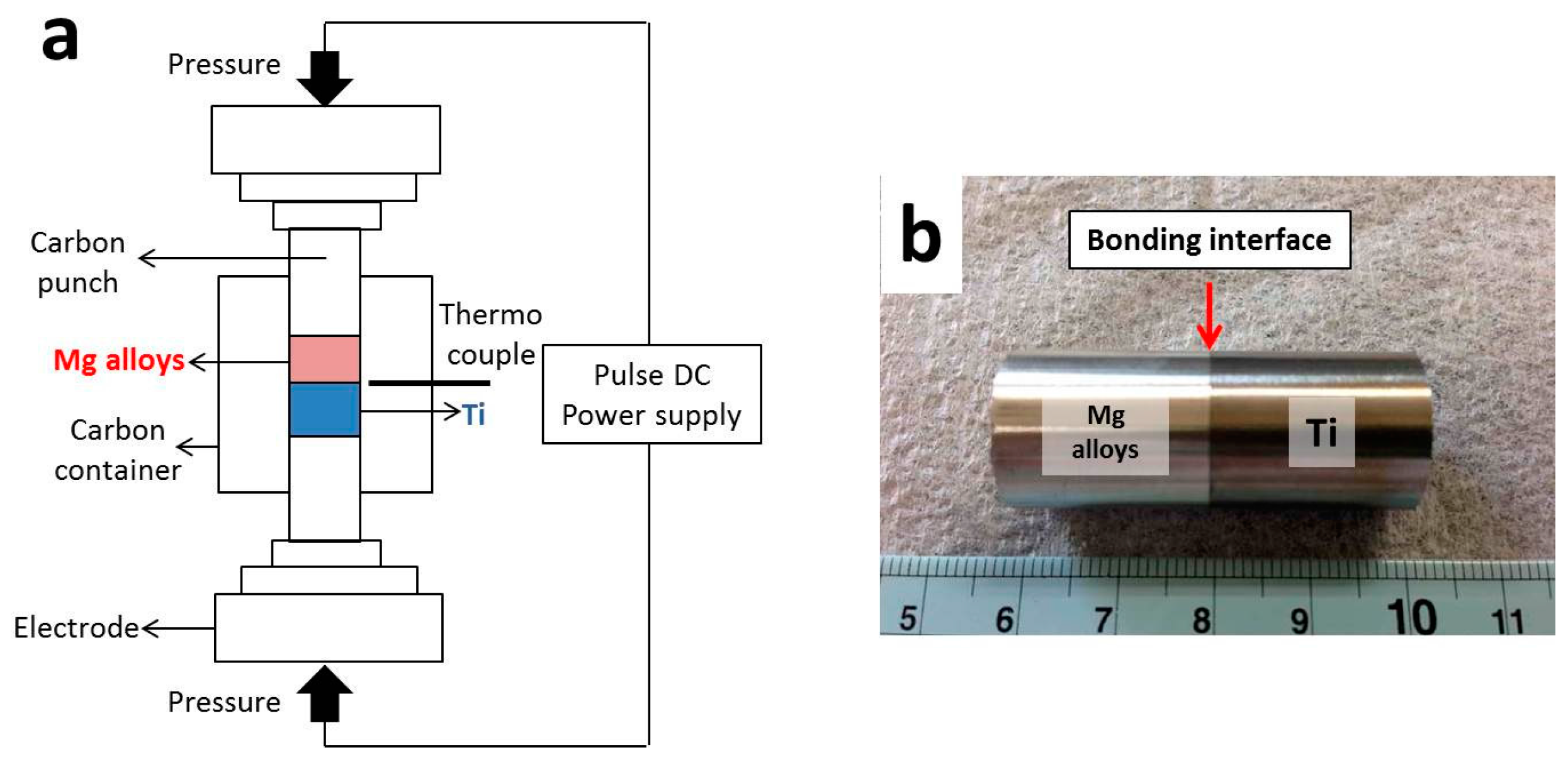
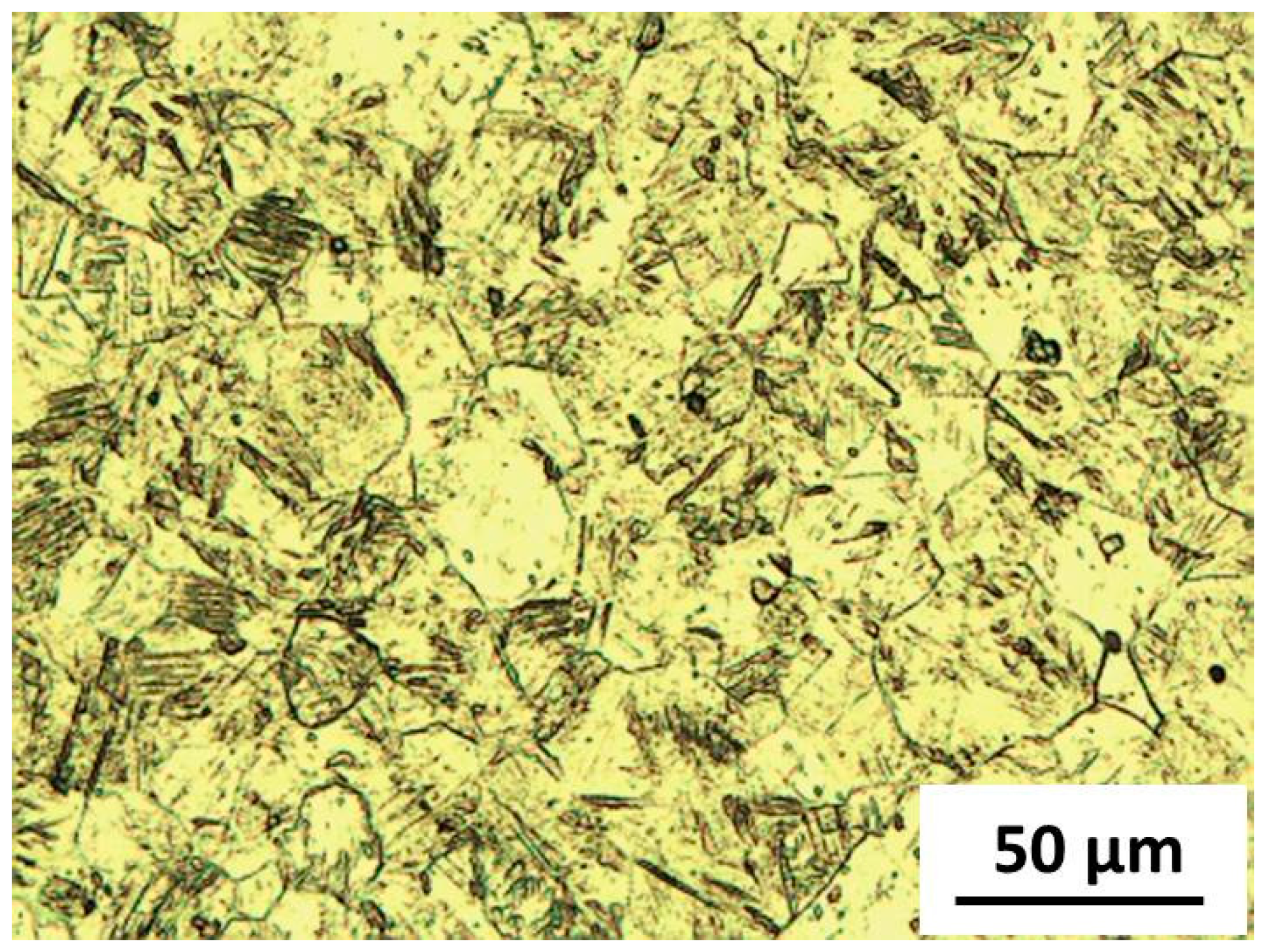
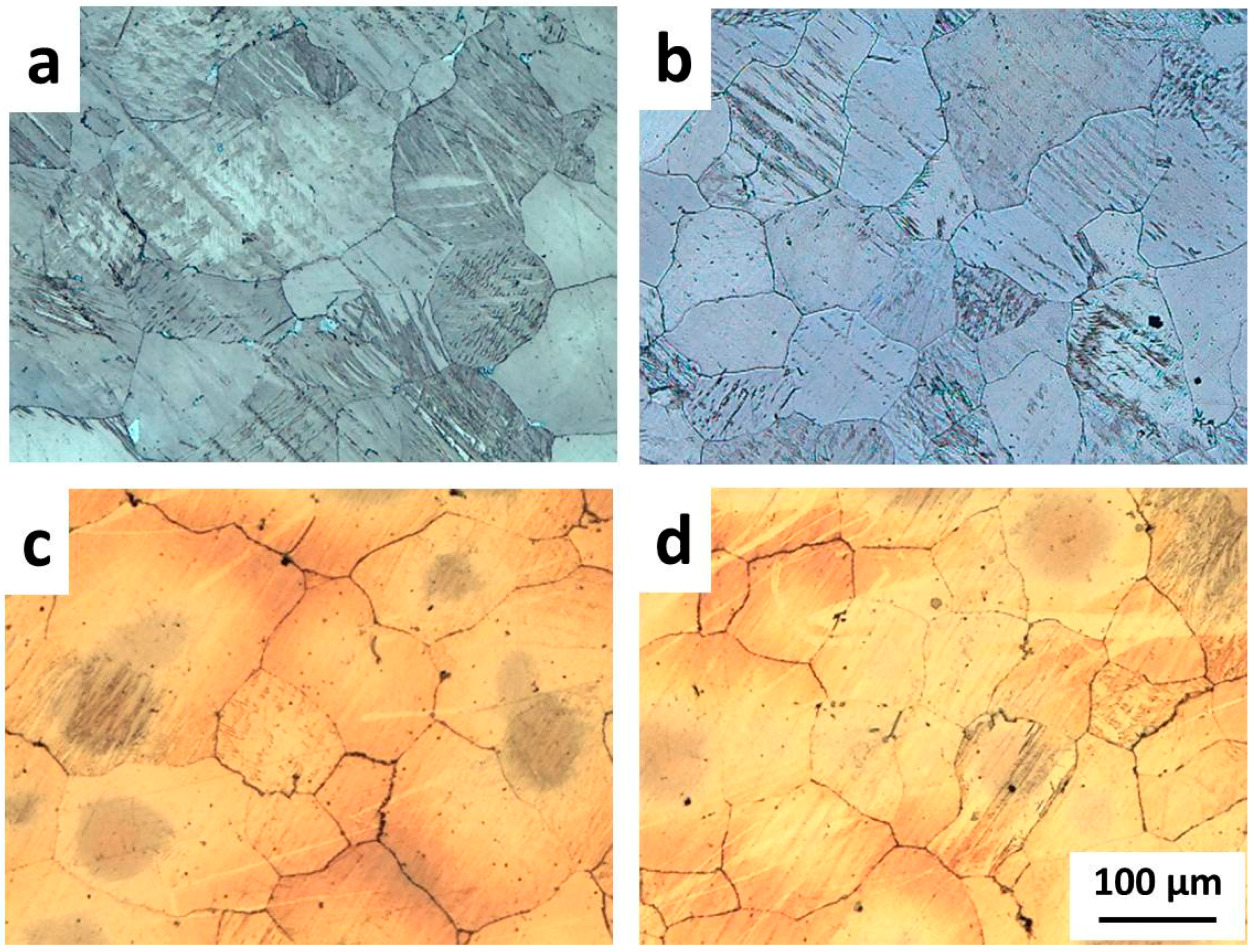
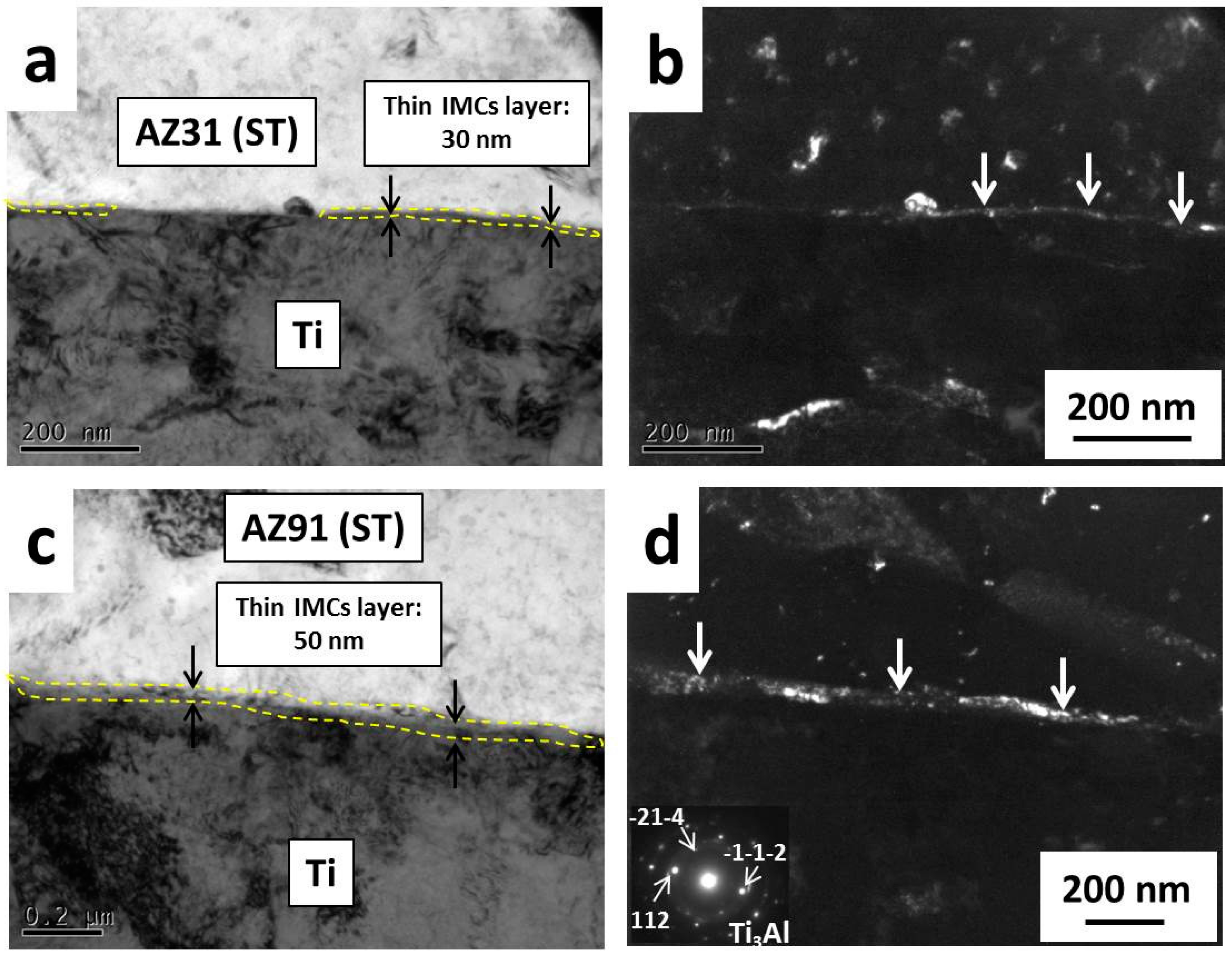
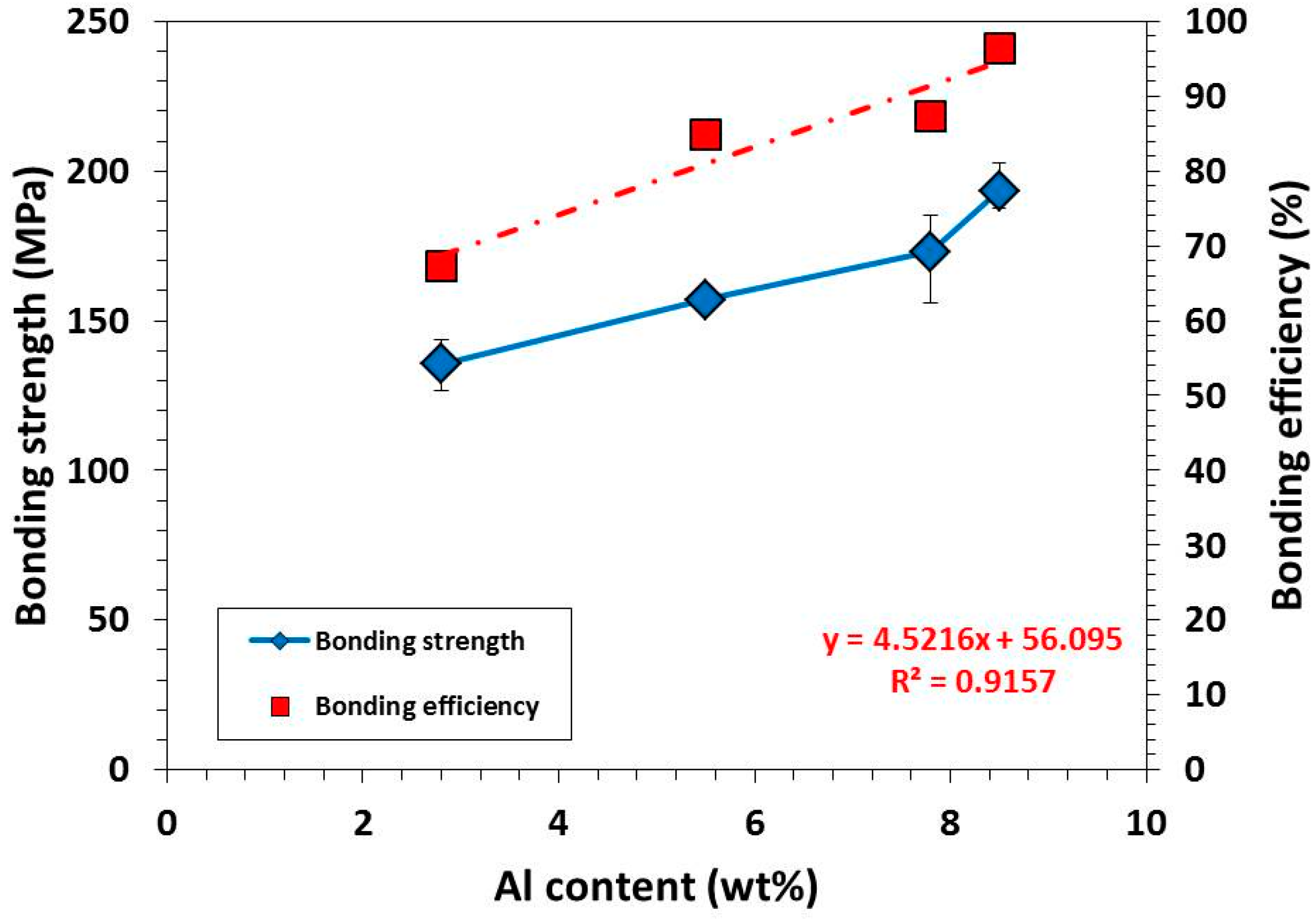
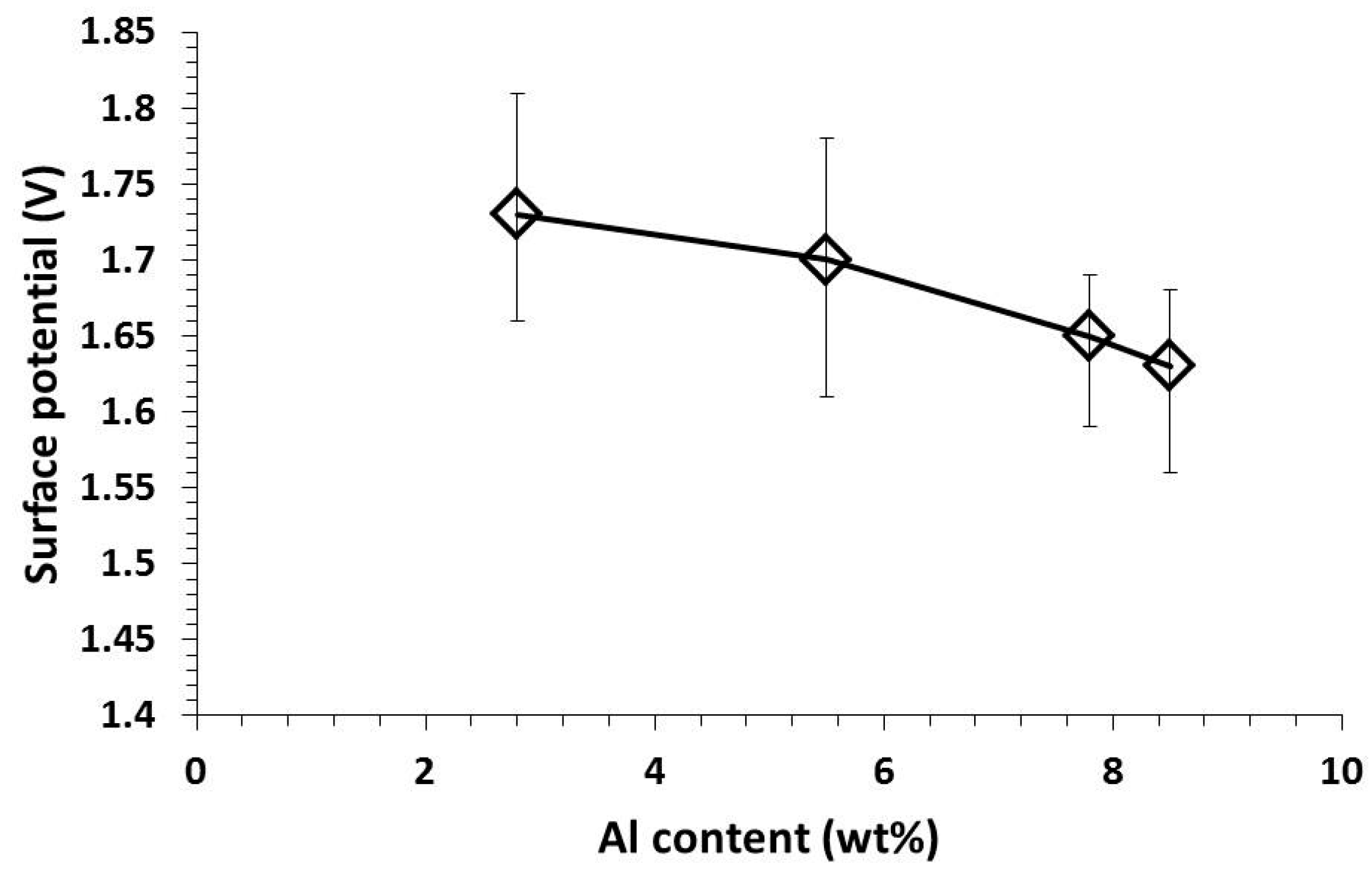

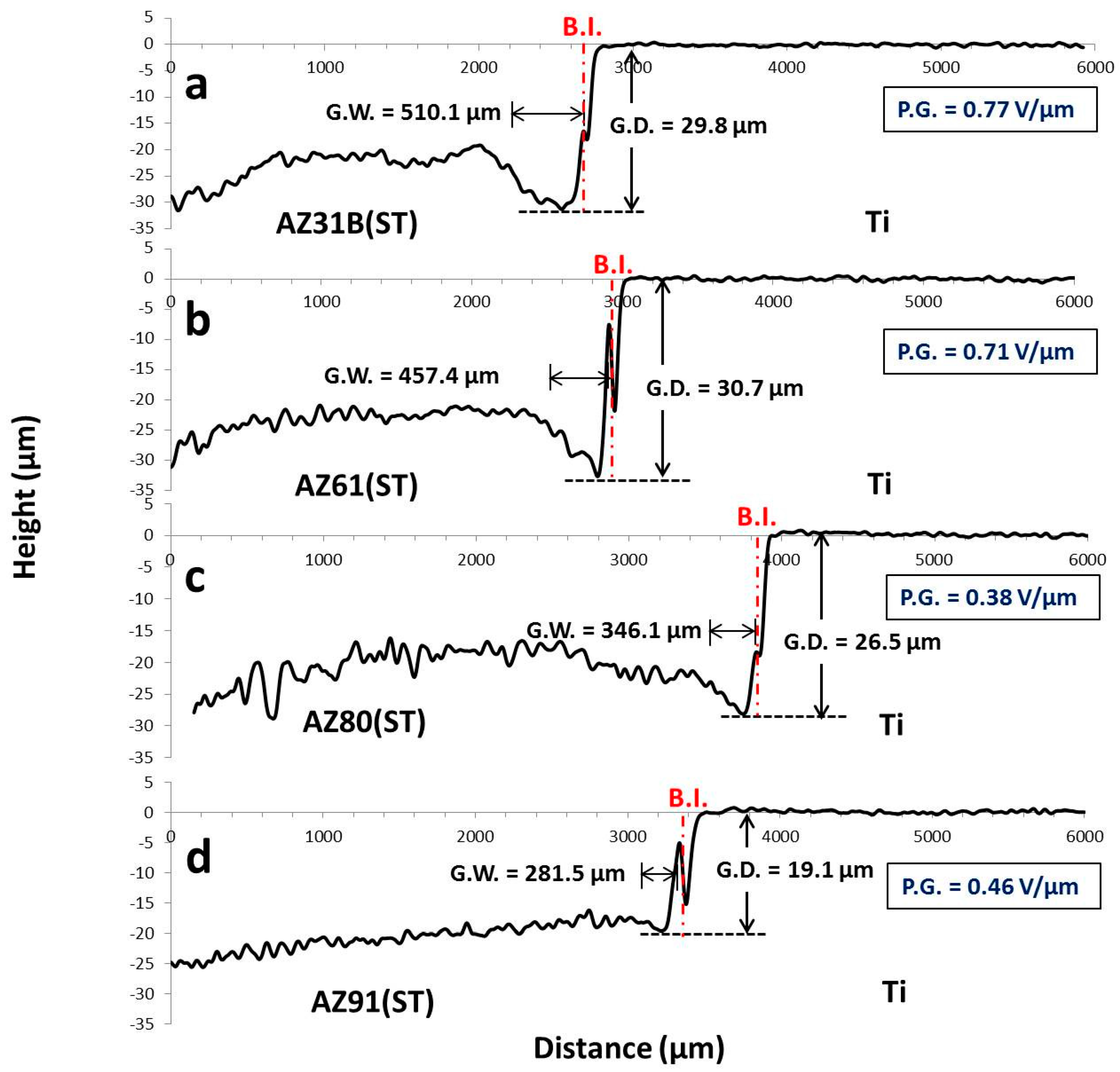
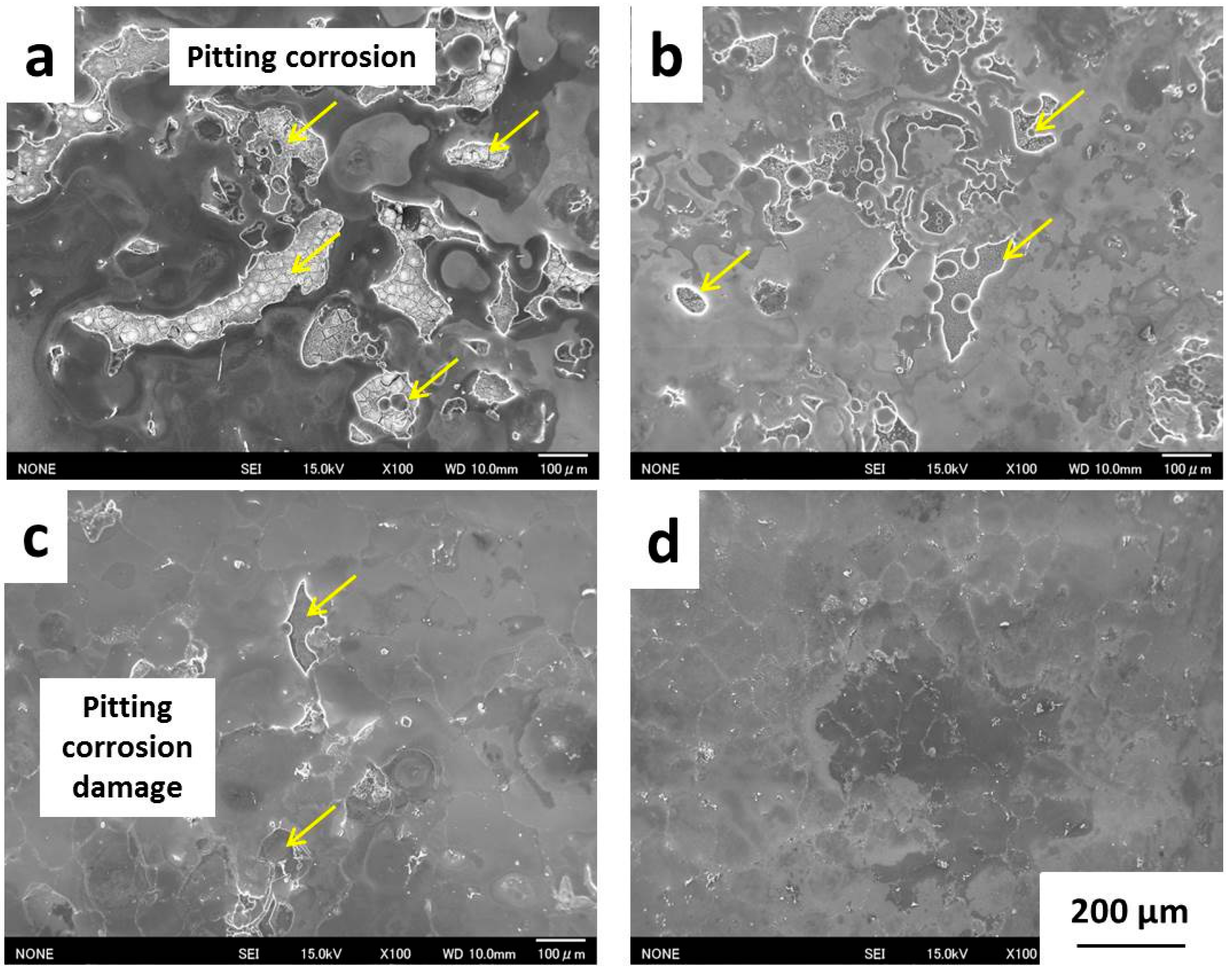
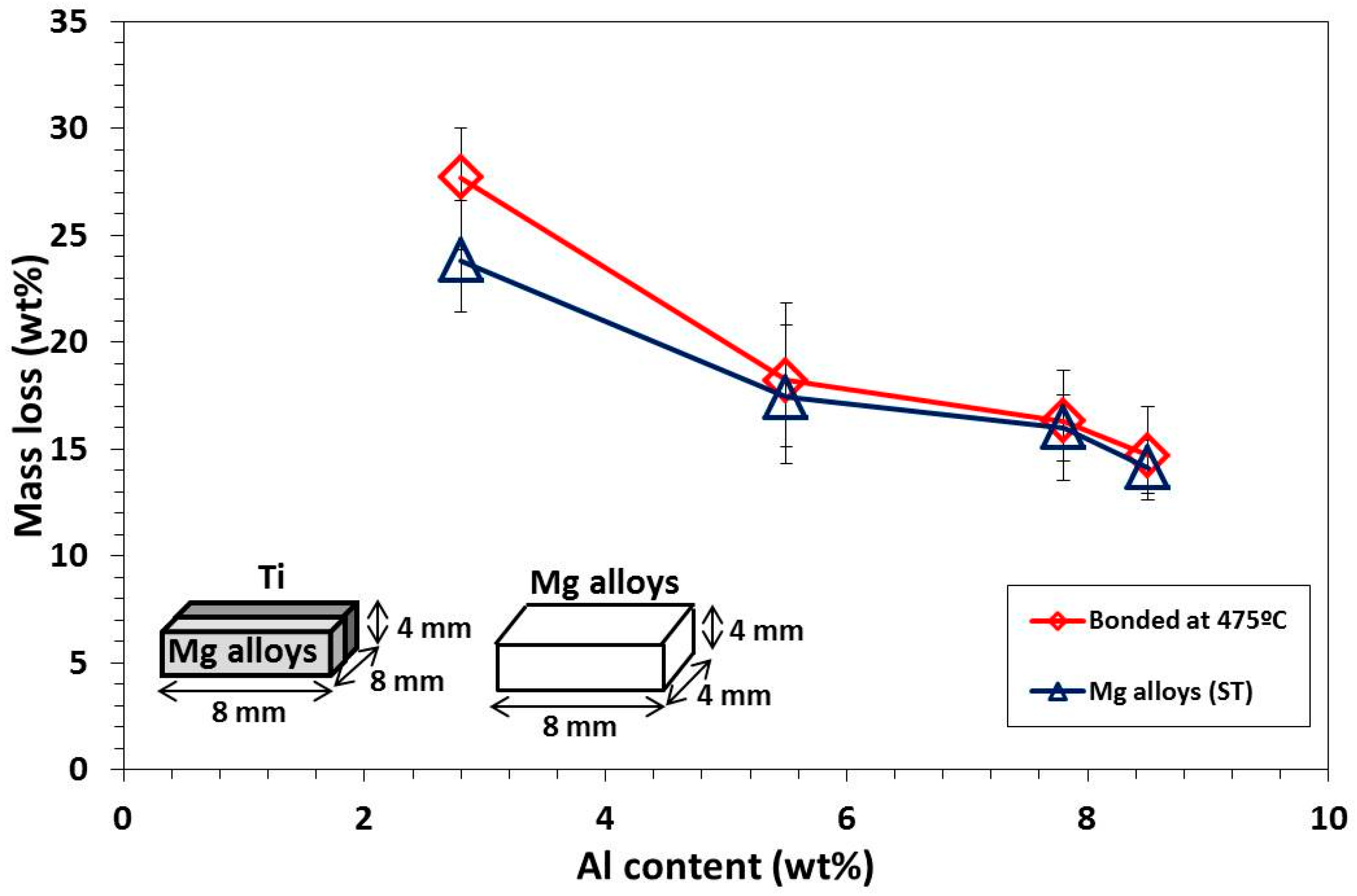
| Material | Ti | Fe | H | O | N |
|---|---|---|---|---|---|
| Pure Ti | Bal. | 0.3 | 0.013 | 0.13 | 0.05 |
| Mg Alloys | Mg | Al | Zn | Mn |
|---|---|---|---|---|
| AZ31B | Bal. | 2.8 | 0.8 | 0.3 |
| AZ61 | Bal. | 5.5 | 0.7 | 0.3 |
| AZ80 | Bal. | 7.8 | 0.3 | 0.4 |
| AZ91 | Bal. | 8.5 | 0.6 | 0.4 |
© 2016 by the authors; licensee MDPI, Basel, Switzerland. This article is an open access article distributed under the terms and conditions of the Creative Commons Attribution (CC-BY) license (http://creativecommons.org/licenses/by/4.0/).
Share and Cite
Pripanapong, P.; Kariya, S.; Luangvaranunt, T.; Umeda, J.; Tsutsumi, S.; Takahashi, M.; Kondoh, K. Corrosion Behavior and Strength of Dissimilar Bonding Material between Ti and Mg Alloys Fabricated by Spark Plasma Sintering. Materials 2016, 9, 665. https://doi.org/10.3390/ma9080665
Pripanapong P, Kariya S, Luangvaranunt T, Umeda J, Tsutsumi S, Takahashi M, Kondoh K. Corrosion Behavior and Strength of Dissimilar Bonding Material between Ti and Mg Alloys Fabricated by Spark Plasma Sintering. Materials. 2016; 9(8):665. https://doi.org/10.3390/ma9080665
Chicago/Turabian StylePripanapong, Patchara, Shota Kariya, Tachai Luangvaranunt, Junko Umeda, Seiichiro Tsutsumi, Makoto Takahashi, and Katsuyoshi Kondoh. 2016. "Corrosion Behavior and Strength of Dissimilar Bonding Material between Ti and Mg Alloys Fabricated by Spark Plasma Sintering" Materials 9, no. 8: 665. https://doi.org/10.3390/ma9080665
APA StylePripanapong, P., Kariya, S., Luangvaranunt, T., Umeda, J., Tsutsumi, S., Takahashi, M., & Kondoh, K. (2016). Corrosion Behavior and Strength of Dissimilar Bonding Material between Ti and Mg Alloys Fabricated by Spark Plasma Sintering. Materials, 9(8), 665. https://doi.org/10.3390/ma9080665







